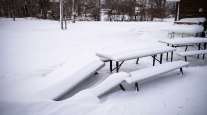Dorian Makes Landfall on Outer Banks Before Heading Out to Sea

[Stay on top of transportation news: Get TTNews in your inbox.]
Hurricane Dorian made landfall on the Outer Banks of North Carolina Sept. 6, battering the shore with driving rain and wind as it continues its march north and begins moving away from the U.S. coast.
Its maximum winds were 90 miles per hour as it scraped Cape Hatteras, marking its first U.S. landfall, the National Hurricane Center reported at 9 a.m. EDT. The Category 1 storm is traveling northeast at 14 mph.
Tropical storm warnings remain in effect for the coast of Maryland and Cape Cod. But Dorian is expected to slowly weaken over the next few days, becoming a post-tropical storm with hurricane-force winds by nightfall on Sept. 7 as it approaches Nova Scotia, Canada.
Almost 400,000 homes and businesses had lost power as of 7:40 a.m., with North and South Carolina taking the brunt of the blackouts. Strong winds have reached southern Virginia, where about 12,000 customers were down, according to utility websites. Power has been restored for the tens of thousands who lost it in most of Florida and Georgia.
The radar view Hurricane Dorian making landfall at Cape Hatteras NC at 835 am this morning. At 10 am Dorian was located 25 mi northeast of Cape Hatteras moving to the northeast at 14 mph. Maximum sustained winds were 90 mph. pic.twitter.com/orw6RwWBAU — NWS Eastern Region (@NWSEastern) September 6, 2019
Dorian was one of the most powerful and longest-lasting storms in modern history, churning its way across the Caribbean and the Atlantic for two weeks. It killed at least 30 people in the Bahamas, battering the island nation with winds as strong as 185 mph. That death toll is likely to increase as search and rescue operations continue, officials said.
Dorian also blew the roofs off of five crude-storage tanks at Equinor ASA’s South Riding Point facility in the Bahamas on its march through the islands, the company said in an email, adding that it’s still too early to determine the volume of spilled oil.
The tanks can hold 6.75 million barrels, almost 1 million tons. The terminal was shut Aug. 31 in preparation for the storm and will remained closed until further notice to assess damages, the company said.
The hurricane couldn’t arrive at a worse time for farmers in the region raising cotton, tobacco, hemp and corn. Fields were maturing, and high winds could deal a potentially devastating blow before farmers have a chance to harvest.
Officials say hundreds, possibly thousands, are still missing after Hurricane Dorian hit the Bahamas
[Tap to expand]https://t.co/7uKoLjHDWD pic.twitter.com/ueGW3nzYau — BBC News (World) (@BBCWorld) September 6, 2019
Dorian is unlikely to be one of the 10 most expensive storms for insurers. Analysts at UBS Group AG estimated the hurricane would spur as much as $10 billion of insured losses overall, a figure placing it outside Swiss Re AG’s list of the 10 worst. UBS cut its estimate from an earlier prediction of $25 billion.
In the Bahamas, authorities and first responders are assessing the damage from the strongest storm to hit the island nation in modern history. Parts of Abaco — the island first hit — are “decimated,” Prime Minister Hubert Minnis said, with “severe damage to homes, businesses and other buildings and infrastructure.”
Minnis said in a tweet earlier in the week that he spoke with President Donald Trump and Canada Prime Minister Justin Trudeau, who both pledged assistance to Grand Bahama and Abaco. Large tracts of homes are under water, and outbreaks of looting are adding to the country’s misery.
The hurricane could cost the Bahamas alone at least $7 billion in insured and uninsured losses, according to an estimate from risk modeler Karen Clark & Co. The preliminary estimate combines damage to commercial, residential and industrial properties as well as business-interruption expenses, the company said in a report. The figure doesn’t include vehicle losses or damage to infrastructure.
“Dorian will go down in history as the worst catastrophe in this region, not only due to the highest recorded wind speed in the North Atlantic but also because the storm stalled over Abaco and Grand Bahama Island for over 24 hours,” Karen Clark said in its report.




